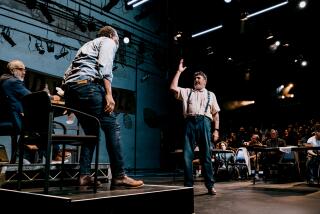STAGE REVIEW : ‘Inspector Hound’: Old Dog With No New Tricks
- Share via
MISSION VIEJO — Tom Stoppard’s legendary reputation as a playwright of great intellectual wit gets put to the test by an over-the-top production of “The Real Inspector Hound” at Saddleback College’s Studio Theatre.
This one-act revival inadvertently manages to reveal that Stoppard’s 1968 parody of Agatha Christie’s London hit, “The Mousetrap,” is little more than a mannered cuckoo clock of a comedy involving a pair of hack drama reviewers who are injected into the plot of a thriller-within-the-play.
For the record:
12:00 a.m. Oct. 17, 1991 For the Record
Los Angeles Times Thursday October 17, 1991 Orange County Edition Calendar Part F Page 2 Column 1 Entertainment Desk 1 inches; 32 words Type of Material: Correction
“Hound” Photo IDs--Actors Julie Brown, Evan Henerson and Derric Michael Neal were shown left to right in a photo that accompanied a review of “The Real Inspector Hound” in Wednesday’s Calendar. The caption misidentified them.
When “The Real Inspector Hound” was staged in its original London production, it derived enormous entertainment value and topical relevance from the fact that after more than 16 years Christie’s whodunit was still running in the West End.
As the longest-running play in London’s modern theatrical history, “The Mousetrap” had become a cultural landmark emblematic of popular taste. It thus made an apt reference point for the kind of sendup that was Stoppard’s clever stock in trade.
Two years earlier, he had taken “Hamlet” as his reference point for “Rosencrantz and Guildenstern Are Dead,” the play that made him famous. But while that dark Stoppard comedy has the ballast of Shakespeare, “The Real Inspector Hound” is tethered to the conventions of a genre with more limited possibilities.
Unless you have a special fondness for the well-made thriller as a theatrical form or a warm appreciation of the period claptrap that Christie used in her classic whodunit, the satirical subversion of the genre in “The Real Inspector Hound” can be as arch as the genre itself.
Everybody in the London audience would have recognized immediately that Muldoon Manor was a burlesque of Monkswell Manor; that Inspector Hound’s arrival in pontoon-like hip boots after crossing a swamp was a spoof of Inspector Trotter’s arrival on skis after a heavy snowstorm; that the fog and the police bulletins over the radio and the crotchety housekeeper, to mention just three parallel points of reference, are all intended to mock a specific model for laughs.
Today, however, Stoppard’s allusions have lost that fresh resonance. What humor they still have depends less on recognition of the particular details he has borrowed from Christie’s play than on a more general idea of the traditional conventions of the well-made thriller.
Consequently, in an amateur production that lacks stylish actors with exquisite timing or a flare for caricature, the stale bones of Stoppard’s overdone script become all too visible. And when missed cues are added to one-note performances, as happened on opening night last week, tedium sets in with unforgiving monotony.
The unique twist of “The Real Inspector Hound” has always been the cartoonish pair of newspaper hacks, Moon and Birdboot, who have come to review the play-within-the-play. Stoppard has claimed, perhaps ingenuously, that “the one thing (‘Hound’) isn’t about . . . is theater critics.” Nevertheless, as the murder mystery unfolds before them (and us) with all its glaring cliches, Moon and Birdboot inevitably become the focus of our attention.
Moon, a second-string drama critic, feels overshadowed by his paper’s first string (“an almost continuous eclipse”) and is a pretentious windbag ever on the lookout for symbolic significance in the plays he is sent to review. Given to weighty pronouncements (“What is the nature of identity?” and “Where is God? I think we are entitled to ask.”), he views the thriller as nothing less than “an austere framework . . . for the human condition.”
Birdboot, on the other hand, has no such pseudo-intellectual inclinations. He is, after all, a first-string tabloid writer with all the instincts of a third-rate critic. He brings a box of chocolates to the theater and judges the play they’re watching to be “a rattling good evening out.” Not that he is without his own ridiculous pretentions. Birdboot, who philanders with young actresses by trading good notices for sex, claims the lead in the role of Cynthia is giving “a performance which I consider to be one of the summits . . . of contemporary theater.”
As for the performance that Terry Christopher gives in the role of Birdboot, it never quite escapes base camp at the foot of the mountain, despite a blustering energy. Monte Collins, as Moon, doggedly climbs a bit higher, particularly with the consistency of his British accent, but he, too, eventually runs out of oxygen.
Among the principals of the thriller-within-the-play, Julie Brown as Cynthia gives the most effective performance with her put-upon caricature of a long-stemmed patrician. But Jill Rollins gets the most laughs with her tics and wobbles as Mrs. Drudge.
The production benefits greatly from Wally Huntoon’s period set design and Charles Castagno’s vintage costumes, both of which establish the right atmosphere.
‘The Real Inspector Hound’
Monte Collins: Moon
Terry Christopher: Birdboot
Jill Rollins: Mrs. Drudge
Evan Henerson: Simon
Teresa Brancaleone: Felicity
Julie Brown: Cynthia
Alan Goodwin: Magnus
Derric Michael Neal: Inspector Hound
Barry Heatherly: BBC Voice
A Saddleback College Department of Theatre Arts production of the Tom Stoppard play. Directed by Patrick J. Fennell. Dialect coach Jane Hebson. Scenic design by Wally Huntoon. Lighting by Kevin Cook. Costumes and makeup by Charles Castagno. Through Oct. 27. At the Studio Theatre, Saddleback College, 28000 Marguerite Parkway, Mission Viejo. Performances are Thursdays to Saturdays at 8 p.m.; Sundays at 3 p.m. Tickets: $6 to $8. Information: (714) 582-4656.
More to Read
The biggest entertainment stories
Get our big stories about Hollywood, film, television, music, arts, culture and more right in your inbox as soon as they publish.
You may occasionally receive promotional content from the Los Angeles Times.










